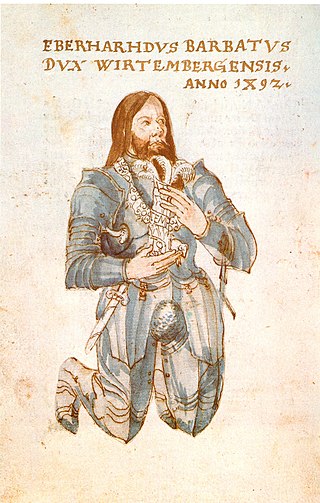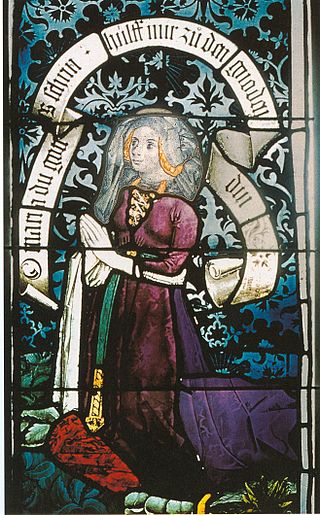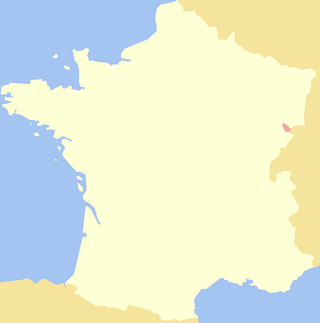
The history of Baden-Württemberg covers the area included in the historical state of Baden, the former Prussian Hohenzollern, and Württemberg, part of the region of Swabia since the 9th century.

Ulrich V, nicknamed the Much-Loved, was Count of Württemberg from 1419 and then count of Württemberg-Stuttgart until his death in 1480.

Eberhard IV, called the Younger, was Count of Württemberg from 1417 until his death in 1419.

Eberhard III, nicknamed the Mild, was Count of Württemberg from 1392 until his death in 1417.

The Duchy of Württemberg was a duchy located in the south-western part of the Holy Roman Empire. It was a state of the Holy Roman Empire from 1495 to 1803. The dukedom's long survival for over three centuries was mainly due to its size, being larger than its immediate neighbors. During the Protestant Reformation, Württemberg faced great pressure from the Catholic emperors to remain loyal. Württemberg resisted repeated French invasions in the 17th and 18th centuries, the duchy being directly in the path of French and Austrian armies who were engaged in the long rivalry between the House of Bourbon and the House of Habsburg. In 1803, Napoleon raised the duchy to be the Electorate of Württemberg. On 1 January 1806, the last elector assumed the title of King of Württemberg. Later that year, on 6 August 1806, the last Emperor, Francis II, abolished the Holy Roman Empire.

Eberhard I of Württemberg was known as Count Eberhard V from 1459 to 1495, and from July 1495 he was the first Duke of Württemberg. He is also known as Eberhard im Bart.

The Treaty of Münsingen was signed on 14 December 1482. This accord officially reunited the divided County of Württemberg after it was divided by the Treaty of Nürtingen in 1442. The hereditary dispute between the Stuttgart part and the part of Urach were settled after 40 years. Residing in Urach, Count Eberhard V, later Duke Eberhard I of Württemberg, obtained rule and moved the capital to Stuttgart. The succession was laid down for the ruling count in the Stuttgart part of the country, Eberhard VI. With this treaty, that was worked out with collaboration of the council of Württembergian subjects, the indivisibility of Württemberg and the primogeniture became contractual. The treaty prevented the division of Württemberg and thus was an important step to the exaltation to a duchy in 1495. The original document is stored in the main public record office in Stuttgart.

Eberhard VI/II was a German nobleman. He was Count of Württemberg-Stuttgart from 1480 to 1496 as Eberhard VI, then Duke of Württemberg from 1496 to June 1498 as Eberhard II.
Ludwig II was the Count of Württemberg. He was the son of count Ludwig I and Mechthild of the Palatinate. He reigned from 1450 until 1457.

Ludwig I was Count of Württemberg from 1419 and then count of Württemberg-Urach until his death in 1450.

Henriette was Sovereign Countess of Montbéliard from 1397 until 1444.

John Frederick of Württemberg was the Duke of Württemberg from 4 February 1608 until his death on 18 July 1628 whilst en route to Heidenheim.

The Princely County of Montbéliard, was a princely county of the Holy Roman Empire seated in the city of Montbéliard in the present-day Franche-Comté region of France. From 1444 onwards it was held by the House of Württemberg. It had full voting rights in the Reichstag.

The coat of arms of the Kingdom of Württemberg shows an impalement of the three black antlers that represent Württemberg on the dexter side, and the three black lions passant of medieval Swabia on the sinister side, both on a gold field.

Eberhard I was Count of Württemberg from 1279 until his death. He was nicknamed 'der Erlauchte' or the Illustrious Highness.

The Treaty of Nürtingen was an agreement signed on 25 January 1442 between Count Ludwig I and his brother Ulrich V that divided the County of Württemberg between them. It is named after the German town of Nürtingen.

Henry of Württemberg was, from 1473 to 1482, count of Montbéliard.

Elizabeth of Brandenburg-Ansbach was a princess of Brandenburg by birth and by marriage Duchess of Württemberg.

Old Württemberg was the princely territory of Württemberg prior to the imperial treaty or Reichsdeputationshauptschluss of 1803, as opposed to the New Württemberg which followed and which acquired a large number of additional territories – especially to the east and south of Old Württemberg.

The Treaty of Tübingen was a treaty signed in the Duchy of Württemberg between its Duke, Ulrich, and the Estates of Württemberg. The treaty concluded the Poor Conrad revolt against Ulrich and annulled his recent taxes on the populace of the Duchy, while the Estates of his realm agreed to liquidate his substantial debts.






















